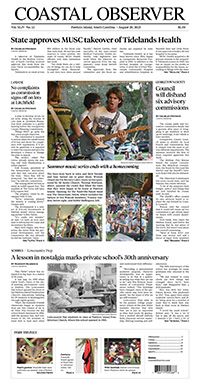Sales tax
County trims $20M from request for dredging

The biggest project proposed for a share of a capital projects sales tax got a little smaller last week.
Georgetown County doesn’t need $21 million to dredge channels in Murrells Inlet.
“That number now is $1 million,” Ray Funnye, the county director of Public Services, said.
He told the Capital Project Sales Tax Commission that numbers were transposed on the application.
The change drops the total amount of requests to under $200 million. When applications were received earlier this month, they topped $250 million.
Requests from Coast RTA for buses and from the town of Pawleys Island for solar powered trash bins were ruled ineligible because they were not considered infrastructure.
The county submitted permit applications last year to state and federal agencies to dredge over 750,000 cubic yards of material from 16.5 miles of creeks and canals in Murrells Inlet to improve boat access at low tide. The applications are still under review.
The state has allocated $14.3 million for the work, which is estimated to cost $39 million, Funnye said.
The county asked the state for another $25 million in the year’s budget, he said.
“Georgetown County, we need to have some skin in the game,” Funnye added, so it still wants to fund $1 million of the work with the sales tax.
Plans call for the work to be done over three years starting next year.
How much money the state provides this year won’t be known until the House and Senate conference committee meets next month to reconcile their budgets.
The House budget includes $15 million for the dredging; the Senate budget includes $5 million, state Sen. Stephen Goldfinch said.
“The question really can’t be answered until conference,” he said. “It’s impossible to say right now.”
The sales tax commission needs to review and score 61 projects – now totaling $190.7 million – and draft a ballot question for County Council to place before voters in a November referendum. The projects will be listed in order of priority and include some that will only be funded if others can’t be completed or there is additional revenue.
The 1-cent sales tax is estimated to generate $10 million a year for up to eight years.
For a long-term project like the Murrells Inlet dredging, the coming in later on the list could be an advantage. If approved by voters, the tax would take effect in May 2025 and revenue would start to reach the county in the late summer.
But the commission will have to make a decision on the ballot by the first week in May. It won’t know how much, if any state funds will be available.
“We’re getting money in the budget every year, but I have no guarantee that we’re going to get the full cost covered,” state Rep. Lee Hewitt said.
He noted that the state Board of Economic Advisors last week postponed its updated revenue forecast last week.
“They’re still trying to get a handle on the revenue we have,” Hewitt said.
Goldfinch said the higher amount for the dredging project included in the House budget reflects a more optimistic revenue forecast. “I hope the higher House number prevails,” he said.
While the lawmakers once saw a request for project funding zeroed out, Goldfinch said he didn’t “get a whole lot of push-back” to the earmark this year.
He also noted that no money from Horry County is included in the funding plan. Several of the creeks and channels most in need of dredging for boat access are across the county line.
“The entire inlet needs to be dredged in order to function properly, that’s what the engineers tell us,” Goldfinch said, so it isn’t likely the project would be scaled back if no funds are provided by Horry County.
Hewitt said he knows Horry County officials are aware of the project, which is being sponsored by Georgetown County.
“Can the state cover it all? Hopefully,” he said.
But Hewitt also pointed out that the scope of the project, and its cost, could be limited by the state and federal permits.
“We don’t know what if anything is going to be permitted,” he said.
The plan calls for most of the dredged materials to be disposed of in the ocean about four-tenths of a mile off Huntington Beach State Park.
“This is the first of the kind for the state,” Funnye told the sales tax commission.
Asked by the members, he also said that dredging will be required again in eight to 10 years.
The Army Corps of Engineers has asked the county for more information about the nearshore disposal site, said Glenn Jeffries, chief of communications for the Charleston District. The agency what to know more about the dredged material and the impacts on the disposal site.
“We anticipate that it will take several months for them to gather sediment samples, conduct laboratory tests, etc.,” she said.




